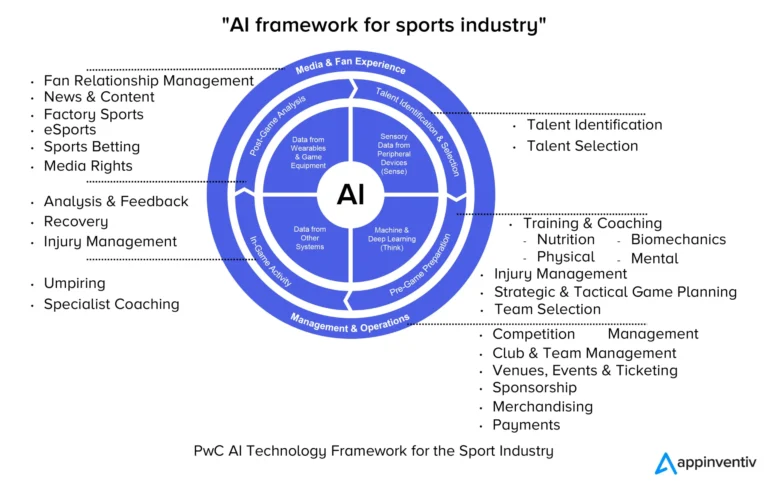LINKS WE LIKE #43
Around the world, sports teams are always on the lookout for ways to improve their game and gain a competitive edge. Traditionally, coaches and players have relied on intuition, personal experience, and gut feelings to make decisions. However, with the increasing applications of big data and artificial intelligence (AI), sports teams are now able to gain data-driven insights that can help them make more informed decisions. Teams and players across various sports such as tennis, football, baseball, lacrosse, hockey, and others have been using these new technologies. Following the diagram below, we will unpack the practical ways in which big data and AI are increasingly being used in sports.
One way we are seeing big data and AI being used in sports is through the way we experience major sporting events. For example, during the 2022 World Cup there were AI-powered cameras and real-time data analysis providing athletes, coaches, and fans with valuable insights. The 15,000 cameras were able to track athletes’ movements and provide real-time data on their performance, in addition to providing the official ball report, which is precise location data on the ball that is updated 500 times per second. This not only allows coaches and analysts to make more informed decisions and commentary, but also helps referees to make the best calls. This is true across many more sporting events, where several other applications such as online betting, predictive tools and news content have allowed fans to engage more actively with their favorite sports.
Another key use of big data and AI is for scouting and recruiting. Some examples include the Major League Baseball (MLB), which is using AI to help teams make better decisions about hiring players, and the National Basketball Association (NBA), which is using AI to improve its scouting process. An advantage of adding AI into scouting is that it has allowed for a democratization in the process, where smaller teams who do not have the resources to hire a scouting team to go over countless hours of footage can now use an AI system to facilitate the scouting process. For example, AiScout, a platform that allows all players (even those in remote areas) to upload videos of themselves doing drills that can then be then analyzed by professional football clubs to scout amateur players from all over the world.
In terms of pre-game preparation, another of the most significant applications of big data is performance analysis. Teams can now use this data to track player performance, monitor injuries, and optimize training routines. It can also be used to create personalized training programs that are tailored to individual players, helping to reduce the risk of injury and improve overall performance. For example, three NHL teams (the Eagles, the Sixers and the Flyers) are using wearable technology to monitor player performance and health through technology developed by Catapult, an Australian-based company developing performance technology. In the same way, companies such as Seattle Sports Sciences and Sparta Science provide teams with machine learning (ML) tools that analyze athletes’ movements to improve their form and even predict injuries. The demand for this type of information on players performance has grown exponentially and it is predicted to continue to grow with a Compound Annual Growth Rate (CAGR) of 24.9% over the next 5 years.
Additionally, there is also the in-game activity component that allows coaches to use data to analyze their opponents’ strengths and weaknesses, identify patterns, and make informed decisions about game strategies. There is also a vast amount of data collected in every game related to passes, goals scored, rebounds, movement speeds, ball trajectories, shot accuracy and others, giving coaches and their teams the ability to analyze these metrics in detail and extract valuable insights. These technologies are already being used, including at the 2022 Winter Olympics, and they can give sport players around the world that extra competitive advantage.
Overall, the use of big data and AI in sports presents many opportunities for teams to improve performance, recruit new players, engage with fans, and optimize strategies. Join us in this edition of Links We Like as we highlight the ways in which these technologies continue to evolve, and their innovative uses in the world of sports.
In a podcast interview hosted by the Science for Sports Podcast, Gemini Sports founder, Jake Schuster describes his journey developing a tool for scouts, coaches, and others involved in the sports industry, who are not data scientists, but need to extract key information for their teams. After a long career in sports, Jake noticed that teams were wasting available data, so he saw the need for a software application that could be a productivity tool for technologists and an accessibility tool for people who don’t know how to code. Based on this observation, he developed Gemini Sports, a no-code app that allows anyone to perform ML projects by uploading any data set and asking key questions about the data. During the interview, Jake explains that big data and AI applications in sports are being used in talent development, analyzing player performance, building tactical models, and forecasting injuries. To illustrate his point he provides the example of one of his clients, a football team, that requested that he analyze different European playing styles (ex: 2006 Barcelona) so they could choose the best style for them. Then based on the chosen style, Jake’s team could analyze what factors were negatively impacting their performance. Finally, based on the insights he could also recommend which new players, within their buying range, could improve their performance.
New technologies have the potential to reduce the risks related to extreme sports such as climbing and alpinism. The most well-known examples include accurate weather forecasts that enable alpinists to plan their hikes and climbs, avoiding potentially deadly conditions, and to bring appropriate equipment, such as lighter ropes, harnesses, or quickdraws. In recent years, the amount of information regarding topographic characteristics of crags, summits and installed equipment (such as bolts and anchors) has been democratized through applications such as the Mountain Project, which brings together a community of climbers willing to share their personal adventures and experiences in service to the global community. Innovative solutions applying big data and AI technologies have been widely welcomed by the sport. One that is especially innovative is the Rock Garden phone application. Providing a fairly accurate 3D topography map of crags, it opens a door for climbers to anticipate and plan their climbs before undertaking any feats that could put their lives into risk. This company gathers information from crags and mountains and exploits it to capture the world’s vertical spaces as they never have been before. The data and images collected are used for four main purposes: map and create immersive interactive climbing navigation tools; connect and collect data with local experts: preserve climbing areas and provide meaningful and sustainable resources to fund local climbing experts.
One of the most exciting things for the dedicated football fans is to replay clips of the best plays from their favorite players and teams in the World Cup. However, finding these videos can take a lot of time and effort. Enter the Watson FIFA World Cup Highlight Machine, designed by FOX Sports and IBM iX in 2018. This platform can go through the 300 archived matches of past World Cups (1958-2018) to find you the perfect video based on the filters you choose by year, team, player, game, play type, or any combination of the above. For example, you could make a highlight video of every penalty shot done by Lionel Messi in every World Cup he has played in; or a video of every corner kick made by the Brazilian team. This application allows fans to extend the conversation after each football match and share their favorite moments of the games with automatically generated clips.
In this video produced by The Economist, we follow the story of the Houston Rockets and their game-changing strategy of incorporating Big Data analysis into every aspect of their game. Data Scientist Daryl Morey was in charge of this transition. The team started using video tracking systems that mined game data by recording 3D spatial data for every player and ball movement at 25 frames per second. These insights allowed coaches to track a wide range of performance metrics, such as shooting percentage, rebounding, assists, and turnovers, to identify the strengths and weaknesses of individual players and the team. This data is then used to create game strategies. In the case of the Houston Rockets, the analysis made them realize that three-point shots had better results than two-point shots, so the team changed their playing style accordingly. The video ends by describing a future where data can be a court-side advisor to coaches as it is expected that it will be able to become real-time functional in the near future.
This article from the Guardian highlights how Wimbledon has turned to big data in order to improve tennis knowledge and engagement among fans. As Alexandra Willis, All England Club’s Director of Communications and Marketing explained, they had noticed that a large percentage of the fans who attended championship games did not watch tennis for the rest of the year and they were unaware of who most players were. To counter this situation Win Factor was created, which is a tool that aggregates data from many sources in order to predict the chance a specific player has of winning a given match. The app will be developed by IBM and it will use two types of data. First, it will rely on physically recorded statistics that have been recorded courtside at every Wimbledon match (about 9.2m tennis data points on record). Additionally, the app will include “sentiment” on players’ features by using media sources that could compromise a player’s Win Factor chances. The hope is that the app will cause fans to engage more actively and become more involved in the entire tennis ecosystem.
Further Afield
Ai Applications in Sports:
- 7 Game-Changing AI Applications in the Sports Industry
- Artificial intelligence is the new competitive edge in sports
- AI in Sports – How is artificial intelligence redefining the sports industry? Real-world example
- How Artificial Intelligence is Transforming the Sports Industry?
- How will #AI change the world of sports?
- Can artificial intelligence help us understand racial bias in sports?
- Does AI spoil the naturalness of sports?
- AI in sports: current trends and future challenges
- Top 10 applications for Artificial Intelligence in the sports industry #ai #techy
Use cases of Ai in sports:
- How artificial intelligence ‘blew up’ tennis
- Moneyball
- France uses artificial intelligence to detect more than 20,000 undeclared swimming pools
- AI-Powered Virtual Coach Takes Swimmers to the Next Level
- A Deep Reinforcement Learning Framework for Optimizing Player Decisions in Soccer
- Artificial Intelligence Teaches Microrobots how to Swim
- Differences between all-around results in women’s artistic gymnastics and
AI and Big Data in the FIFA World Cup 2022
- Science and the World Cup: how big data is transforming football
- Data Science at The 2022 World Cup
- World Cup 2022: crunching 150 years of big data to predict the winner
- How Big Data was used in this Fifa World Cup?
- This World Cup is wired and fueled by AI
- Interesting Ways the AI Is Affecting the 2022 FIFA World Cup Sports
- Tech and the World Cup: 7 Ways AI Has Transformed Football





![M002 - Feature Blog Post [WEB]](https://datapopalliance.org/wp-content/uploads/2025/10/M002-Feature-Blog-Post-WEB.png)





